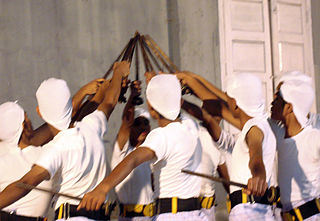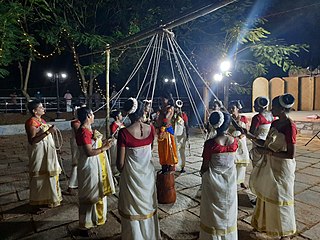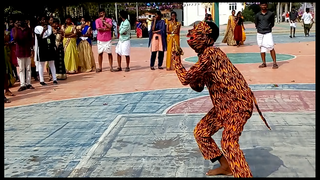See also
| | This article about Indian dance is a stub. You can help Wikipedia by expanding it. |
- ↑ "Mangalam Kali - a folk art form | Kerala Folk art forms". www.keralaculture.org. Retrieved 28 November 2022.
Mangalamkali is a dance ritual related to marriage functions as a form of entertainment. [1] Usually mavilas (a tribe in kasaragod and kannur districts Kerala (state of south India) perform this. Certain music instruments too are used like thudi. The dance movement gradually become fast.

The Malayali people are a Dravidian ethnolinguistic group originating from the present-day state of Kerala in India, occupying its southwestern Malabar coast. They are predominantly native speakers of the Malayalam language, one of the six Classical languages in India. The state of Kerala was created in 1956 through the States Reorganisation Act. Prior to that, since the 1800s existed the Kingdom of Cochin, the Kingdom of Travancore, Malabar District, and South Canara of the British India. The Malabar District was annexed by the British through the Third Mysore War (1790–92) from Tipu Sultan. Before that, the Malabar District was under various kingdoms including the Zamorins of Calicut, Kingdom of Tanur, Arakkal kingdom, Kolathunadu, Valluvanad, and Palakkad Rajas.

Dance in India comprises numerous styles of dances, generally classified as classical or folk. As with other aspects of Indian culture, different forms of dances originated in different parts of India, developed according to the local traditions and also imbibed elements from other parts of the country.

Theyyam also called Theyyattam, are ritual dance forms performed in northern Kerala and few parts of Karnataka. Theyyam consists of traditions, rituals and customs associated with temples and sacred groves of Malabar. It broadly encompasses Hindu ritualistic tenets. The people of the region consider Theyyam itself as a channel to a god and they thus seek blessings from Theyyam. Theyyam is a centuries-old unique art form of North Malabar. In Kasaragod and Kannur districts, this ritual art is mainly performed in the kavus (Temple) or ancestral houses of Nambiar, Thiyyar, Vaniyar and Maniyani communities.

Poorakkali is a traditional dance ritual performed by men during the nine-day Pooram festival in Bhagavathy temples across North Malabar in Kerala State of south India.

Lokanarkavu Temple is an ancient Hindu temple situated in Memunda 4 km from Vatakara, in Kozhikode District, North Malabar region of Kerala state of south India. Lokanarkavu is a short form of Lokamalayarkavu which means lokam (world) made of mala (mountain), aaru (river) and kavu (grove). The closest railway station is at Vatakara, which is 5 km from temple. The nearest airport is Kannur airport which is 54 km away.

Kolkali is a folk art performed in Malabar region of Kerala, India. The dance performers move in a circle, striking small sticks and keeping rhythm with special steps. The circle expands and contracts as the dance progress. The accompanying music gradually rises in pitch and the dance reaches its climax. Kolkali is now a popular event in Kerala School Kalolsavam, which is considered as the biggest cultural event of Asia. There are two styles of Kolkali: the actual Kolkali and Thekkan Koladi. The actual Kolkali consists of Thacholikali, Rajasooyam etc. The actual kolkali is almost at verge of extinction and Thekkan Koladi is still alive as it is added in state kololsavams.
Thacholikali is a folk art performed during the Mandala Utsavam, forty-one day annual festival at the Lokanarkavu Bhagavathy Temple. Lokanarkavu temple is situated 5 km from Vatakara, a small town in Kerala state of South India. This dance, performed during the festival resembles the martial art Kalarippayattu.

The culture of Kerala has developed over the past millennia, influences from other parts of India and abroad. It is defined by its antiquity and the organic continuity sustained by the Malayali people. Modern Kerala society took shape owing to migrations from different parts of India and abroad throughout Classical Antiquity.

Chavittu Nadakam (Malayalam:ചവിട്ടുനാടകം) is a highly colorful Latin Christian classical art form originated in Ernakulam district, Kerala state in India. Commonly believed that Fort Kochi is the birthplace of Chavittu Nadakam. It is noted for its attractive make-up of characters, their elaborate costumes, detailed gestures and well-defined body movements presented in tune with the rhythmic playback music and complementary percussion. This art form highly resembles European opera.

Margamkali is an ancient Indian round dance of the St. Thomas Christians community- based in Kerala state, mainly practiced by the endogamous sub-sect known as the Knanaya or Southist Christians. The dance retells the life and missionary work of Thomas the Apostle, based on the 3rd-century apocryphal Acts of Thomas.

Mudiyettu is a traditional ritual theatre and folk dance drama from Kerala that enacts the mythological tale of a battle between the goddess Kali and the demon Darika. The ritual is a part of the bhagavathi or bhadrakali cult. The dance is performed in bhadrakali temples, the temples of the Mother Goddess, between February and May after the harvesting season.

Charadupinnikali or Urikkali is a dance form practiced in South Kerala and by ex-pat communities in other countries. The play is performed holding the cords hung at the place of performance. At the end of play, the cords become a rough form of uri and later the uri is undone. This makes a part of Thiruvathira.

Kerala, a state situated on the tropical Malabar Coast of southwestern India, is one of the most popular tourist destinations in the country. Named as one of the ten paradises of the world by National Geographic Traveler, Kerala is famous especially for its ecotourism initiatives and beautiful backwaters. Its unique culture and traditions, coupled with its varied demography, have made Kerala one of the most popular tourist destinations in the world. Growing at a rate of 13.31%, the tourism industry is a major contributor to the state's economy.

Puli kali is a recreational folk art from the state of Kerala, India. It is performed by trained artists to entertain people on the occasion of Onam, an annual harvest festival, celebrated mainly in the Indian state of Kerala. On the fourth day of Onam celebrations, performers painted like tigers and leopards in bright yellow, red, and black shake their bellies and dance to the beats of instruments like Udukku and Thakil. Literal meaning of Pulikkali is 'The tiger dance' hence the performance revolve around the theme of tiger hunting. Folk art is mainly practiced in Thrissur district of Kerala. The best place to watch the show is at Thrissur on the fourth day of Onam, where Pulikkali troupes from all over the district assemble to display their skills. The festival attracts thousands of people to the Thrissur city. Pulikkali is also performed during various other festive seasons.

Kummattikali or Kummatti Kali is the famous colorful mask-dance of Kerala, prevalent in Thrissur District, Palakkad District and parts of South Malabar. During the festival of Onam, Kummattikali performers move from house to house collecting small gifts and entertaining people. Kummatti dances are rampant in the Thrissur district during Onam. Pristine or original form of Kummattikali can be seen in the Bhadrakali temple in Palakkad district. Kerala

Puliyattam is an old folk art dance of Tamil Nadu. A highly exuberant and cultural festival, this dance form usually comprises a troupe of 6 performers aping the movements of the majestic, predatory tigers. Their bodies are painted by the painstaking efforts of local artists in vibrant yellow and black to resemble an exact replica of a tiger. The paintings include the ferocious looking fangs and convincing headgear replete with ears, paws with claws, and a long tail that conjures an accurate picture of the savage beast’s graceful movements.

Padayani, also known Padeni, is a traditional folk dance and a ritual art from the central portion of the Indian state of Kerala. A ceremonial dance involving masks, it is an ancient ritual performed in Bhagavati temples. The dance is performed in honor of Bhadrakaali. Meaning, a 'row of warriors', Padayani is an art form that blends all music, dance, theatre, satire, facial masks, and paintings. It is part of worship of Bhadrakali and is staged in temples dedicated to the goddess from mid-December to mid-May. Padayani is unique to central Travancore, comprising the Pathanamthitta and kottayam districts of Kerala. Padayani is regarded as a remnant of the Dravidian forms of worship that existed before the advent of Brahmanism.

Poothamkali is folk art form in state of Kerala, India. This art form uses various types of decorations in the costume. It is usually performs in the Bhagavathy temples of Malappuram district. It is based on the myth of durga and her combat with Darika asura.